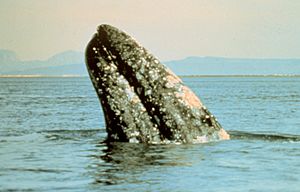Ojo de Liebre Lagoon facts for kids
Quick facts for kids
Designations
|
|
| Official name: Laguna Ojo de Liebre | |
| Designated: | 2 February 2004 |
|---|---|
| Reference #: | 1339 |


Ojo de Liebre Lagoon is also known as Scammon's Lagoon. Its name means "hare eye lagoon" in English. This large coastal lagoon is found in Mulegé Municipality in Mexico. It is near the town of Guerrero Negro in the state of Baja California Sur.
The lagoon is about halfway between the southern tip of the Baja California Peninsula and the U.S.-Mexico border. It opens up to the Pacific Ocean.
Ojo de Liebre Lagoon is part of the Vizcaíno Biosphere Reserve. This reserve is a UNESCO World Heritage Site. The lagoon is also a special wetlands site. It is home to the world's largest commercial saltworks plant.
This lagoon is a very important place for many animals. Gray whales come here to have their babies and spend the winter. Harbor seals also live here. Other marine mammals like California sea lions, northern elephant seals, and even blue whales visit. Four types of endangered marine turtles also lay their eggs here. In winter, many different kinds of water birds find a safe home in the lagoon.
Laguna Ojo de Liebre shows how nature and industry can exist in the same place. It is both a protected UNESCO site and a big salt factory. In the past, too much tourism was a problem for the gray whales. Now, tourism is carefully managed to protect them.
Contents
Geography of Ojo de Liebre Lagoon
Laguna Ojo de Liebre is a big, shallow, salty area of water. It is about 9 kilometers (5.6 miles) wide and 4 kilometers (2.5 miles) long. Its depth ranges from 5 to 12 meters (16 to 39 feet). Deeper channels cut through the lagoon. These channels are found between wide, flat areas that are covered and uncovered by tides.
The weather here is dry and warm. The temperature usually stays between 18°C and 22°C (64°F and 72°F). Sometimes there is no rain at all in a year, or it can rain up to 200 millimeters (7.9 inches). The lagoon is surrounded by sand dunes that are 12 to 15 meters (39 to 49 feet) tall. These dunes have plants that don't grow very strongly. There are also sandy beaches, some with sandbanks.
How the Lagoon Formed
Scientists have studied the geology of Laguna Ojo de Liebre. They believe it started as a small beach on the coast of Baja California. This was when the ocean was about 12 meters (39 feet) lower than it is today. As the tides changed, openings formed in the land. Over time, sand and dirt from nearby rivers built up. This created a natural barrier that formed the lagoon we see today.
The Salt Plant
Industry has changed the lagoon and the area around it. There are large, rectangular ponds where seawater is evaporated to collect salt. You can also see big, flat areas of salt. Other barriers and channels have been built to hold and flood shallow pools of salty water on the eastern side of the lagoon. These areas often look yellowish-green in pictures.
The Ojo de Liebre lagoon is home to the world's largest saltworks plant. It is called Exportadora de Sal S.A. (ESSA). This company makes salt by pumping seawater into huge ponds. These ponds cover an area of 33,000 hectares (81,545 acres).
The salt plant creates a leftover liquid called "bittern." This liquid is discharged into the lagoon. In December 1997, many green turtles were found dead. This happened weeks after the company released bitterns into the lagoon. Investigations showed that the bitterns contained high levels of certain substances. This was much higher than what is found in normal seawater.
History of the Lagoon
In December 1857, a man named Charles Melville Scammon sailed into Laguna Ojo de Liebre. He came with his ship, the Boston, and another small boat. Their goal was to hunt the gray whales that came to the lagoon to have their babies. They caught twenty whales.
Scammon returned the next winter (1858–59) with more ships. He caught 47 female whales. Other ships joined him and caught even more whales. Many ships visited the lagoon in the winter of 1859-60. However, they caught fewer whales that season.
Over the next few years, fewer and fewer whales were found. By the winter of 1872-73, only a very small amount of whale oil was collected. After that, whale hunting in the lagoon stopped. The whales had been hunted so much that there were not enough left.
See also
 In Spanish: Laguna Ojo de Liebre para niños
In Spanish: Laguna Ojo de Liebre para niños
- Natural history of Baja California Sur
- Ramsar sites in Mexico


